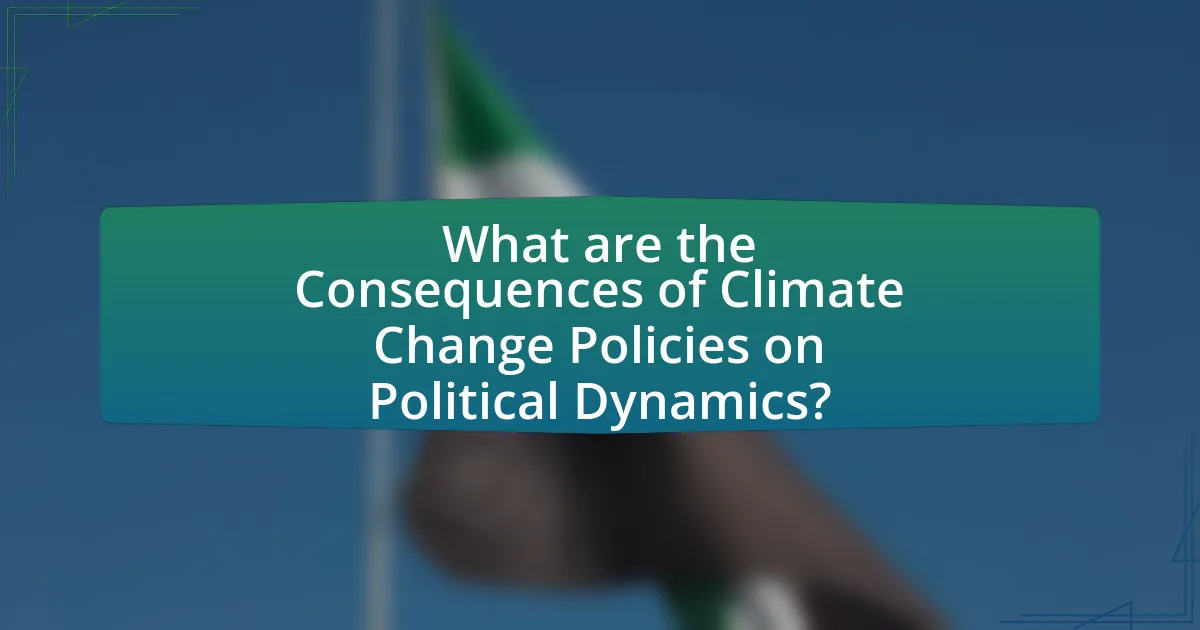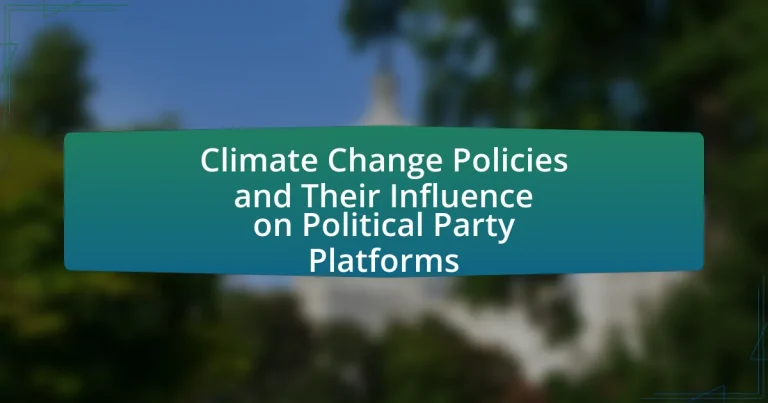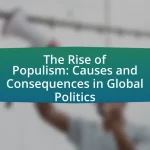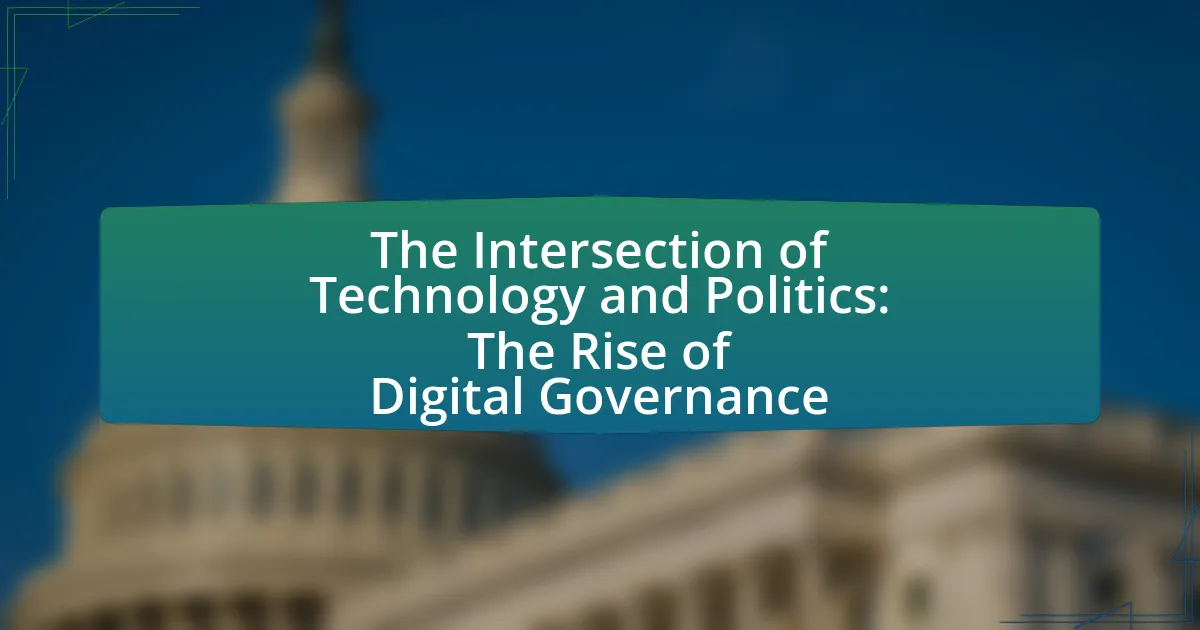Climate change policies are strategic frameworks established by governments to combat climate change and promote sustainability. These policies are essential for reducing greenhouse gas emissions, enhancing energy efficiency, and fostering renewable energy adoption, as exemplified by international agreements like the Paris Agreement. The article explores the impact of climate change policies on global environmental efforts, their role in sustainable development, and how they shape political party platforms. It also examines the influence of public opinion, electoral pressures, and interest groups on party positions regarding climate action, highlighting the challenges and best practices for effective policy implementation.

What are Climate Change Policies and Their Importance?
Climate change policies are strategic frameworks and regulations implemented by governments to mitigate the effects of climate change and promote sustainable practices. These policies are crucial because they aim to reduce greenhouse gas emissions, enhance energy efficiency, and promote renewable energy sources, thereby addressing the urgent challenges posed by global warming. For instance, the Paris Agreement, adopted in 2015, commits countries to limit global temperature rise to below 2 degrees Celsius, highlighting the international consensus on the need for effective climate action. Additionally, research from the Intergovernmental Panel on Climate Change (IPCC) indicates that without robust climate policies, the world could face severe environmental, economic, and social consequences, underscoring the importance of these policies in safeguarding future generations.
How do Climate Change Policies impact global environmental efforts?
Climate change policies significantly enhance global environmental efforts by establishing frameworks for emission reductions and promoting sustainable practices. These policies, such as the Paris Agreement, compel nations to commit to specific targets for greenhouse gas emissions, fostering international cooperation. For instance, the commitment of over 190 countries to limit global warming to below 2 degrees Celsius has led to increased investments in renewable energy and energy efficiency. Additionally, climate policies often include mechanisms for funding and technology transfer, which support developing countries in their environmental initiatives. This collaborative approach not only addresses climate change but also contributes to biodiversity conservation and sustainable development, demonstrating the interconnectedness of climate action and broader environmental goals.
What are the key components of effective Climate Change Policies?
Effective climate change policies include regulatory frameworks, economic incentives, public awareness campaigns, and international cooperation. Regulatory frameworks establish legally binding emissions targets and standards, which are essential for reducing greenhouse gas emissions. Economic incentives, such as tax credits for renewable energy and penalties for high emissions, encourage businesses and individuals to adopt sustainable practices. Public awareness campaigns educate citizens about climate change impacts and promote behavioral changes. International cooperation is crucial, as climate change is a global issue requiring coordinated efforts, exemplified by agreements like the Paris Accord, which aims to limit global warming to well below 2 degrees Celsius.
How do these policies address greenhouse gas emissions?
These policies address greenhouse gas emissions by implementing regulatory frameworks that set limits on emissions from various sectors, including transportation, energy production, and agriculture. For instance, many countries have adopted carbon pricing mechanisms, such as cap-and-trade systems, which create financial incentives for reducing emissions. According to the World Bank, as of 2021, over 60 carbon pricing initiatives have been implemented globally, covering approximately 22% of global greenhouse gas emissions. Additionally, policies promoting renewable energy sources, such as wind and solar, directly contribute to reducing reliance on fossil fuels, which are the primary source of greenhouse gas emissions. The International Renewable Energy Agency reported that renewable energy capacity has increased significantly, leading to a reduction of around 1.8 gigatons of CO2 emissions in 2020 alone.
Why are Climate Change Policies essential for sustainable development?
Climate change policies are essential for sustainable development because they provide a framework for reducing greenhouse gas emissions and promoting environmental resilience. These policies facilitate the transition to renewable energy sources, which is crucial for mitigating climate change impacts that threaten ecosystems, economies, and human health. For instance, the Intergovernmental Panel on Climate Change (IPCC) reports that limiting global warming to 1.5 degrees Celsius requires immediate and substantial reductions in emissions, underscoring the need for effective climate policies. By integrating climate considerations into development strategies, nations can ensure long-term economic stability, social equity, and environmental protection, thereby fostering a sustainable future.
What role do these policies play in economic growth?
Climate change policies play a crucial role in economic growth by promoting sustainable practices that can lead to innovation and job creation. These policies encourage investment in renewable energy, which has been shown to generate more jobs per unit of energy produced compared to fossil fuels. For instance, a report from the International Renewable Energy Agency indicates that the renewable energy sector employed over 11 million people globally in 2018, a number that continues to rise as countries implement more stringent climate policies. Additionally, transitioning to a low-carbon economy can enhance energy efficiency, reduce costs, and stimulate economic activity, ultimately contributing to long-term growth.
How do they influence social equity and justice?
Climate change policies influence social equity and justice by addressing disparities in environmental impacts and resource access. These policies often aim to reduce greenhouse gas emissions while ensuring that marginalized communities, who are disproportionately affected by climate change, receive support and resources for adaptation and resilience. For instance, the implementation of renewable energy initiatives can create job opportunities in low-income areas, promoting economic equity. Additionally, studies show that equitable climate policies can lead to improved health outcomes in disadvantaged populations, as they often face higher pollution levels. Thus, effective climate change policies can serve as a mechanism for advancing social equity and justice by prioritizing the needs of vulnerable communities.

How do Climate Change Policies Shape Political Party Platforms?
Climate change policies significantly shape political party platforms by influencing their positions on environmental issues, economic strategies, and social justice. Political parties often adopt climate change policies to align with public concern over environmental degradation and to attract voters who prioritize sustainability. For instance, the Democratic Party in the United States has increasingly integrated climate action into its platform, advocating for the Green New Deal, which aims to address climate change while promoting economic equity. This shift reflects a broader trend where parties recognize that climate policies can mobilize support and differentiate them from opponents. Additionally, research indicates that parties that embrace strong climate policies tend to gain electoral advantages, as seen in various elections where climate-focused candidates have performed well, demonstrating the direct impact of climate change policies on party platforms.
What are the main ways political parties incorporate Climate Change Policies?
Political parties incorporate climate change policies primarily through legislative proposals, party platforms, and public advocacy. Legislative proposals often include specific bills aimed at reducing carbon emissions, promoting renewable energy, and enhancing climate resilience. For instance, the Green New Deal proposed by some U.S. lawmakers outlines comprehensive measures to address climate change while creating jobs. Party platforms serve as official documents that outline a party’s stance on climate issues, often reflecting commitments to international agreements like the Paris Accord. Public advocacy involves campaigns and outreach efforts to raise awareness about climate change and mobilize voter support for climate initiatives. These methods collectively demonstrate how political parties prioritize climate change in their agendas, influencing both policy-making and public perception.
How do party platforms reflect public opinion on climate change?
Party platforms reflect public opinion on climate change by incorporating policies that align with the prevailing attitudes and concerns of the electorate. For instance, as public awareness and concern about climate change have increased, many political parties have adopted more aggressive climate action proposals, such as transitioning to renewable energy and reducing carbon emissions. According to a 2021 Pew Research Center survey, 70% of Americans view climate change as a major threat, prompting parties to adjust their platforms to resonate with this sentiment. This alignment is evident in the Democratic Party’s emphasis on the Green New Deal, which aims to address climate change through comprehensive reforms, reflecting the urgency expressed by constituents.
What strategies do parties use to advocate for climate policies?
Political parties advocate for climate policies through a combination of legislative proposals, public campaigns, coalition-building, and grassroots mobilization. Legislative proposals involve drafting and promoting specific laws aimed at reducing carbon emissions and enhancing sustainability, such as the Green New Deal in the United States, which aims to address climate change while creating jobs. Public campaigns utilize media and social platforms to raise awareness and garner public support for climate initiatives, often highlighting the urgency of climate action through statistics and expert testimonials. Coalition-building involves forming alliances with environmental organizations, businesses, and other stakeholders to strengthen advocacy efforts and increase political pressure for climate action. Grassroots mobilization engages citizens directly, encouraging them to participate in demonstrations, sign petitions, and contact their representatives, thereby amplifying the demand for climate policies. These strategies collectively enhance the visibility and urgency of climate issues within political discourse, influencing party platforms and policy decisions.
Why do political parties prioritize certain Climate Change Policies over others?
Political parties prioritize certain climate change policies over others primarily due to their ideological beliefs, electoral strategies, and the influence of interest groups. For instance, parties with a strong environmental focus, such as the Green Party, emphasize aggressive climate action to align with their core values and attract environmentally conscious voters. In contrast, parties that rely on fossil fuel industries may prioritize policies that support economic growth over stringent environmental regulations. Additionally, research indicates that public opinion significantly shapes party platforms; for example, a 2021 Pew Research Center study found that 67% of Americans view climate change as a major threat, prompting parties to adopt policies that resonate with voter concerns. Thus, the prioritization of climate change policies is a strategic decision influenced by a combination of ideology, electoral considerations, and public sentiment.
What factors influence a party’s stance on climate issues?
A party’s stance on climate issues is influenced by its ideological beliefs, economic interests, public opinion, and scientific consensus. Ideologically, parties may align with environmentalism or prioritize economic growth, affecting their climate policies. Economic interests play a crucial role, as parties representing industries like fossil fuels may resist stringent climate regulations, while those aligned with renewable energy may advocate for aggressive climate action. Public opinion significantly shapes party positions; parties often adjust their policies to reflect the views of their constituents, especially as awareness of climate change grows. Lastly, the scientific consensus on climate change impacts party stances, as parties that acknowledge scientific findings are more likely to support comprehensive climate policies.
How do electoral pressures affect policy choices?
Electoral pressures significantly influence policy choices by compelling political parties to align their platforms with voter preferences to secure electoral success. For instance, in the context of climate change policies, parties may adopt more aggressive environmental regulations or renewable energy initiatives in response to growing public concern about climate issues, as evidenced by the increasing number of voters prioritizing climate action in polls. Research conducted by the Yale Program on Climate Change Communication indicates that 70% of Americans support government action on climate change, prompting political parties to integrate such policies into their platforms to attract these voters. This alignment between electoral pressures and policy choices demonstrates how the need for electoral viability can shape legislative agendas, particularly in response to pressing societal issues like climate change.

What are the Consequences of Climate Change Policies on Political Dynamics?
Climate change policies significantly alter political dynamics by reshaping party platforms and voter alignments. For instance, the adoption of stringent climate regulations often leads to a realignment of political parties, with progressive parties gaining support from environmentally conscious voters while conservative parties may lose ground among those prioritizing climate action. A study by the Pew Research Center in 2021 indicated that 70% of Democrats view climate change as a major threat, compared to only 27% of Republicans, highlighting the polarization in political perspectives on climate issues. This divergence influences legislative priorities, electoral strategies, and coalition-building efforts, ultimately affecting governance and policy implementation.
How do Climate Change Policies affect party competition and alliances?
Climate change policies significantly influence party competition and alliances by reshaping political platforms and voter priorities. As parties adopt more aggressive climate policies, they often differentiate themselves from opponents, leading to increased competition for environmentally conscious voters. For instance, in the 2020 U.S. elections, the Democratic Party’s emphasis on the Green New Deal attracted younger voters concerned about climate change, while the Republican Party faced pressure to address climate issues to retain support among moderate constituents. This dynamic can lead to strategic alliances, such as coalitions between progressive parties and environmental organizations, aimed at promoting comprehensive climate action. Additionally, parties may form temporary alliances to push specific climate legislation, reflecting a shift in political strategy driven by public demand for climate action.
What impact do these policies have on voter behavior?
Climate change policies significantly influence voter behavior by shaping public perceptions and priorities regarding environmental issues. Research indicates that voters are increasingly motivated to support candidates and parties that prioritize climate action, with surveys showing that 70% of voters consider climate change a critical issue in elections. This shift in voter sentiment has led political parties to adopt more aggressive climate policies to align with constituents’ preferences, thereby impacting electoral outcomes. For instance, in the 2020 U.S. elections, candidates who emphasized climate change in their platforms saw increased support, particularly among younger voters, highlighting the direct correlation between climate policy advocacy and voter mobilization.
How do they influence coalition-building among parties?
Climate change policies influence coalition-building among parties by aligning their platforms on shared environmental goals. When parties prioritize climate action, they often seek alliances with others that advocate for similar policies, facilitating collaboration on legislation and electoral strategies. For instance, in the 2020 U.S. elections, Democratic candidates unified around climate initiatives, which helped them form coalitions with environmental groups and progressive factions, ultimately strengthening their electoral base. This alignment demonstrates how shared climate objectives can drive parties to collaborate, enhancing their collective influence in governance.
What challenges do political parties face in implementing Climate Change Policies?
Political parties face significant challenges in implementing climate change policies, primarily due to conflicting interests among stakeholders. These conflicts arise from the need to balance economic growth with environmental sustainability, as many industries, such as fossil fuels, resist regulations that could impact their profitability. Additionally, political parties often encounter public skepticism regarding climate change, which can hinder their ability to garner support for ambitious policies. For instance, a 2021 survey by the Pew Research Center indicated that only 54% of Americans believe that climate change is a major threat, reflecting a divided public opinion that complicates policy advocacy. Furthermore, the lack of consensus within parties themselves can lead to internal divisions, making it difficult to present a unified front on climate initiatives. These factors collectively impede the effective implementation of climate change policies by political parties.
How do internal party disagreements affect policy formulation?
Internal party disagreements significantly hinder effective policy formulation by creating divisions that complicate consensus-building. When members of a political party hold conflicting views on climate change policies, it leads to fragmented agendas and diluted proposals, making it challenging to present a unified stance. For instance, during the 2020 Democratic primaries, disagreements over the Green New Deal among candidates illustrated how internal conflicts can stall the development of cohesive climate policies. This fragmentation often results in missed opportunities for comprehensive legislation, as parties struggle to reconcile differing priorities and strategies.
What external pressures do parties encounter from interest groups?
Political parties encounter various external pressures from interest groups, particularly in the context of climate change policies. These pressures manifest through lobbying efforts, public campaigns, and financial contributions aimed at influencing party platforms and legislative agendas. For instance, environmental organizations may mobilize grassroots support to advocate for stricter climate regulations, compelling parties to align their policies with public sentiment or risk losing voter support. Additionally, interest groups often provide research and data that can shape party positions, as seen in the influence of groups like the Sierra Club or Greenpeace, which actively campaign for sustainable practices and policies. This dynamic illustrates how interest groups can significantly impact the political landscape by pushing parties to adopt more environmentally focused platforms.
What best practices can political parties adopt regarding Climate Change Policies?
Political parties can adopt best practices for Climate Change Policies by prioritizing evidence-based strategies, engaging in transparent communication, and fostering collaboration with stakeholders. Evidence-based strategies involve utilizing scientific research and data to inform policy decisions, ensuring that actions are grounded in proven effectiveness. For instance, the Intergovernmental Panel on Climate Change (IPCC) provides comprehensive assessments that can guide policy formulation. Transparent communication helps build public trust and encourages community involvement, as seen in successful campaigns that actively involve citizens in climate initiatives. Collaboration with stakeholders, including businesses, NGOs, and local communities, enhances policy effectiveness and fosters a sense of shared responsibility, as demonstrated by initiatives like the Global Covenant of Mayors for Climate and Energy, which unites local governments in climate action.
How can parties effectively communicate their climate agendas to the public?
Parties can effectively communicate their climate agendas to the public by utilizing clear messaging, engaging storytelling, and leveraging multiple communication channels. Clear messaging ensures that the core objectives of the climate agenda are easily understood, while engaging storytelling helps to connect emotionally with the audience, making the issues more relatable. For instance, the use of personal narratives or case studies can illustrate the real-world impacts of climate change, enhancing public engagement. Additionally, leveraging multiple communication channels, such as social media, traditional media, and community events, allows parties to reach diverse audiences effectively. Research indicates that campaigns that utilize a mix of platforms can increase message retention and public support, as seen in the 2020 U.S. elections where climate issues gained significant attention through various media outlets.
What role does collaboration with environmental organizations play in policy development?
Collaboration with environmental organizations plays a crucial role in policy development by providing expertise, advocacy, and public support for sustainable practices. These organizations often conduct research, gather data, and offer insights that inform policymakers about environmental issues, ensuring that policies are grounded in scientific evidence. For instance, the collaboration between the Environmental Defense Fund and the U.S. government led to the successful implementation of the cap-and-trade system, which significantly reduced greenhouse gas emissions. This partnership exemplifies how environmental organizations can influence policy by leveraging their knowledge and mobilizing public opinion, ultimately shaping effective climate change policies that align with political party platforms.




